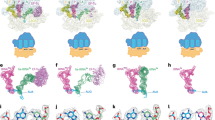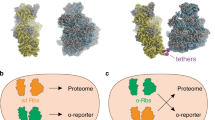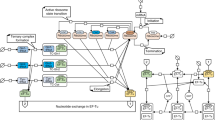Abstract
IN Escherichia coli, protein synthesis is initiated with for-mylmethionine, coded by the triplet AUG. As the first step in translation, ribosomes bind to the AUG initiator codon in the presence of initiation factors, charged fMet-tRNA and GTP. The sequence or structure of a messenger RNA molecule must signal that a particular AUG triplet is an initiation codon, and the cell's ribosomes must recognise this region as containing a signal for initiation of translation. In a reaction suitable for in vitro protein synthesis, except that it contains only one species of charged tRNA, fMet-tRNA, ribosomes bind to and protect initiation regions from nuclease digestion. The ribosomes bind at the AUG initiator codon and cannot proceed any further due to the lack of charged tRNA species other than fMet-tRNA. In the hope of determining the characteristics peculiar to an initiation region in a mRNA molecule, a number of ribosome binding sites have been sequenced1–8.
This is a preview of subscription content, access via your institution
Access options
Subscribe to this journal
Receive 51 print issues and online access
$199.00 per year
only $3.90 per issue
Buy this article
- Purchase on Springer Link
- Instant access to full article PDF
Prices may be subject to local taxes which are calculated during checkout
Similar content being viewed by others
References
Steitz, J. A., Nature, 224, 957–964 (1969).
Staples, D. H., and Hindley, J., Nature new Biol., 234, 211–212 (1971).
Staples, D. H., Hindley, J., Billeter, M. A., and Weissmann, C., Nature new Biol., 234, 202–204 (1971).
Robertson, H. D., Barrell, B. G., Weith, H. L., and Donelson, J. E., Nature new Biol., 241, 38–40 (1973).
Hindley, J., and Staples, D. H., Nature, 224, 964–967 (1969).
Gupta, S. L., Chen, J., Schaefer, L., Lengyel, P., and Weissman, S. M., Biochem. biophys. Res. Commun., 39, 883–888 (1970).
Arrand, J. R., and Hindley, J., Nature new Biol., 244, 10–13 (1973).
Steitz, J. A., J. molec. Biol., 73, 1–16 (1973).
Maizels, N. M., Proc natn. Acad. Sci. U.S.A., 70, 3585–3589 (1973).
Zabin, I., and Fowler, A. V., J. biol. Chem., 247, 5432–5435 (1972).
DeWachter, R., Merregaert, J., Vandenberghe, A., Contreras, R., and Fiers, W., Eur. J. Biochem., 22, 400–414 (1971).
Volckaert, G., and Fiers, W., FEBS Lett., 35, 91–96 (1973).
Ganem, D., Miller, J. H., Files, J. G., Platt, T., and Weber, K., Proc. natn. Acad. Sci. U.S.A., 70, 3165–3169 (1973).
Files, J. G., Weber, K. K., and Miller, J. H., Proc. natn. Acad. Sci. U.S.A. (in the press).
Anderson, J. S., Bretscher, M., Clark, B. F. C., and Marcker, K. A., Nature, 215, 490–492 (1967).
Kondo, M., Eggerston, G., Eisenstadt, J., and Lengyel, P., Nature, 220, 368–370 (1968).
Barrell, B. G., in Procedures in Nucleic Acid Research (edit. by Cantoni, G. L., and Davies, D. R.), 2, 751–779 (Harper and Row, New York, 1971).
Author information
Authors and Affiliations
Rights and permissions
About this article
Cite this article
MAIZELS, N. E. coli lactose operon ribosome binding site. Nature 249, 647–649 (1974). https://doi.org/10.1038/249647b0
Received:
Issue Date:
DOI: https://doi.org/10.1038/249647b0
This article is cited by
-
The functional stability of the lacZ transcript is sensitive towards sequence alterations immediately downstream of the ribosome binding site
Molecular and General Genetics MGG (1987)
-
Human tumour necrosis factor: precursor structure, expression and homology to lymphotoxin
Nature (1984)
-
Identification and chemical synthesis of a tandemly repeated immunogenic region of Plasmodium knowlesi circumsporozoite protein
Nature (1983)
-
Sequence of the lactose permease gene
Nature (1980)
-
Escherichia coli lac operator mRNA affects translation initiation of β-galactosidase mRNA
Nature (1979)
Comments
By submitting a comment you agree to abide by our Terms and Community Guidelines. If you find something abusive or that does not comply with our terms or guidelines please flag it as inappropriate.



